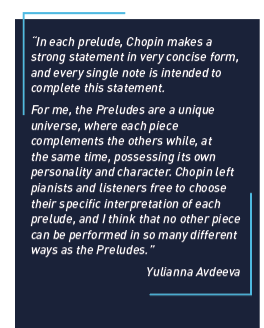Composed 1838-9; 39 minutes
“Themes are descending on me like swarms of bees,” Chopin wrote while working on his Preludes. “I keep on noting them down…They will make preludes. Only I don’t know whether I will scrape together 48 of them, like Bach.” In the end, Chopin composed 24 pieces—each a concise, self-contained inspiration, ranging in length from under a minute to around five. Together, they move through the full circle of fifths, with each major key followed by its relative minor.
Franz Liszt, who heard Chopin perform several of the Preludes in a rare public concert on April 26, 1841, wrote: “They are poetic preludes, like those of a great contemporary poet, which gently brush the keyboard but leave deep imprints on the soul…They possess that freedom and charm which characterize works of genius.” Despite their apparent spontaneity, Liszt emphasized the meticulous thought and craftsmanship behind them.
Although often performed as a complete cycle today, Chopin’s Preludes also reflect an earlier tradition. The verb ‘préluder’ referred to warming up—both pianist and audience—before the main work of a recital. It also allowed a player to ‘get the feel’ of an instrument, and, for those with Chopin’s improvisational flair, to captivate with spontaneous invention. Such ‘preludes’ valued the fleeting and intuitive over formal structure. As not all pianists could improvise effectively, a market emerged for ready-made sets of brief, all-purpose preludes, often organized in all the major and minor keys. Before Chopin’s Op. 28, composers such as Carl Czerny had already published collections in this form. Back in Warsaw, Johann Kessler had dedicated a similar cycle of Preludes to Chopin in 1835.
The earliest of the Op. 28 Preludes, the one in A major, dates from 1836, and another, in A-flat major, was ready for copying by Julian Fontana in 1837. Most of the set was either drafted or underway when Chopin and his new partner, the novelist George Sand, fled the gossip of Paris and set sail for the island of Mallorca in November 1838. A contract for the collection had already been signed with the Paris firm Pleyel, and Chopin was eagerly anticipating further work on the collection while renting a three-room monk’s cell in a former Carthusian monastery in Valldemossa, a secluded mountain village in the island’s scenic Tramuntana range. Since he composed at the piano, he had to wait weeks for the delivery of a small Pleyel upright from Paris.
The famous ‘Raindrop’ Prelude in D-flat is traditionally said to date from the December rains in the isolated monastery—its repeated, ‘dripping’ A-flats, enharmonically transformed to ghostly G-sharps in the turbulent central section. Sand initiated the story after traveling down the rocky roads in the torrential rains with one of her children to buy provisions, returning on foot, shoeless and soaked,  abandoned by their cart driver. There they found Chopin distressed by imagined ghosts haunting the dark monastery, sitting at his piano with “heavy, icy drops, falling rhythmically on his chest.” Sand went on to write in her Histoire de ma vie, “His composition that evening was full of raindrops resonating on the tiles of the monastery.” That was 15 years later, five years after Chopin had died and was no longer around to confirm weather reports. [In fact, the architecture of the monastery precluded anything but the sound of the rain falling on the garden below the monk’s cell, as the English poet and historical novelist Robert Graves confirmed long ago]. The D-flat Prelude, nevertheless, remains one of the more evocative of Chopin’s Preludes.
abandoned by their cart driver. There they found Chopin distressed by imagined ghosts haunting the dark monastery, sitting at his piano with “heavy, icy drops, falling rhythmically on his chest.” Sand went on to write in her Histoire de ma vie, “His composition that evening was full of raindrops resonating on the tiles of the monastery.” That was 15 years later, five years after Chopin had died and was no longer around to confirm weather reports. [In fact, the architecture of the monastery precluded anything but the sound of the rain falling on the garden below the monk’s cell, as the English poet and historical novelist Robert Graves confirmed long ago]. The D-flat Prelude, nevertheless, remains one of the more evocative of Chopin’s Preludes.
Nothing is superfluous in this collection. Chopin avoids empty virtuosity, musical ideas are stripped to their essence. The harmonic daring and concision of Op. 28 laid the groundwork for composers like Debussy, Scriabin, and Szymanowski. Today, no one asks “Preludes to what?” nor wonders if Chopin ever wrote the missing fugues. These are concert preludes—self-contained, emotionally rich miniatures. As French pianist Alfred Cortot once wrote: “Each Prelude is a secret, revealed only to those who listen with the soul as well as the ear.”
— All program notes copyright © 2025 Keith Horner.
Comments welcomed: khnotes@sympatico.ca